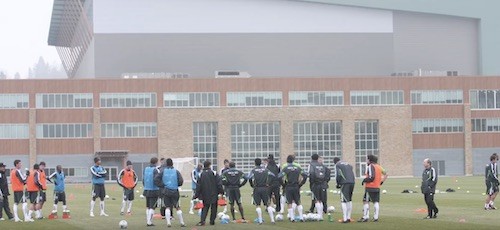| Even professional soccer players like the Seattle Sounders Brad Evans adjusted his game as he got older, playing different positions and playing more within himself. That’s what top pro soccer players do as they get older. But even younger players can take some of this to heart. And the best soccer players in the world, like Lionel Messi and Cristiano Ronaldo, are always trying to get better and improve different parts of their game as they get older.
Lionel Messi said he wants to “improve”, which is an amazing statement from the world’s best soccer player. If you REALLY want to help your developing and growing soccer players’ long term development, then this article is for you. If you’re simply trying to win the next game, then maybe it’s not. In this article I will address an issue I have seen and dealt with for years and at ALL levels of soccer; the failure to return to the core skills and relearning what we have forgotten. It’s not just a “rare occurrence”, it happens everywhere in soccer… All around the U.S. players are getting worse with age? I know, I know… it sounds strange, many will disagree about “their player(s)”, but it’s true and I see it almost everywhere I go. As time goes on it seems we lose focus on player CORE skill development and start worrying about that “next game”. We are concerned about team rankings, championships, tournaments, and results rather than focusing on the most important thing we can do. Continually developing skilled players. I will warn you… it is often hard for the coach and parent to see this through their “own eyes”. We spent years developing the SoccerU series. Literally hundreds of hours in the field capturing the essence of soccer skill training, breaking it down, and then putting it in a form that ALL could use to improve their players. We worked with ALL levels of players from young 7 year olds, to college players, and even professional players from around the world. The funny part is many people think it is just for “young youth players”. Nothing could be further from the truth. We have coaches from all over the country writing us to thank us. Many of these coaches work with older players including high school players and even a few college coaches that now use the series to develop incoming players or returning players from summer breaks. If there was one message I could get out to ALL coaches, it would be… return to basics for at least a portion of EVERY practice. He’s calling again… He played top level competitive soccer as a youth, played ODP, RPL, and the usual top level teams for his age. He was a star player in high school, played college soccer, and recently made the reserve team for a processional team. Once in a while he’ll give me a call and ask me to work with him. However, most people are kind of shocked when they see us training. They expect to see some “magical professional” sessions, however we return to basics. We are doing the exact same touches, and core skills we work with in the SoccerU series. Yes, the VERY SAME soccer skills we are teaching to younger players. You’ll understand WHY, in a little bit. Here come the college girls… I hadn’t seen her in almost 2 years, and then one day I got a phone call from her dad. He was wondering if I’d be willing to work with her and a few of her teammates during the summer. What he didn’t know is that for the first time in many years, I was kind of taking the summer off. But, he was persistent. So I agreed. Most of the girls were seniors in college now and had years and years of playing and training under their belts. We met each morning early before the heat kicked in too heavy. We trained for 3 hours each day. Here’s the “shocker” for you, not me. Most of these girls had trouble performing core and basic skills. Wait a minute… didn’t I just done saying these were great players, playing in college on scholarships, and could REALLY play? Yep… you heard correctly. It might surprise YOU, but it is VERY common and I see it all the time, good or even great OLDER players that lack many core skills and touch. When we were done with the training sessions I talked to them in great length about what I did with them. They all agreed and understood the point I’m making here. As we get older as players, less and less time is devoted to core skills, touch control, and literally dozens and dozens of needed skills on the field. The focus is shifted to winning games. These core skills, will often never be revisited again and become distant to our instinctive playing nature. They all said the same thing, “I wish our soccer coaches would do this for an hour of each practice rather than running us to death or just scrimmaging all the time.” Their words, not mine. The soccer coach is there to win, not develop your child… A funny thing happens when “kids” start to turn into young adults. Some of life’s cruel lessons start to hit them. (As well as their parents.) This usually happens about the time school team sports come along. Let’s say about the 8th grade or 13 / 14 years old. All of a sudden there are tryouts, and guess what? If you don’t make the team, you go home, you can’t play. The coach looks at the players that come out for tryouts and has to pick his 20. All the others get to go home. (What a monster.) It sounds horrible because it goes against everything that we have learned and stated about “youth soccer” in the growing years. We play ALL players, we shouldn’t care about winning, and we should focus on player development. Well guess what? You just had your first job interview and you didn’t get the job. Sometimes life stinks. It’s kind of harsh to say, but it is a reality when it comes to “older” and school sports. The soccer coach, at this level, has one main job, and that job is to win. Honestly, most teams at this level have very little time to prepare for the season and for practice during the season. The focus will be put on a few specific areas. Conditioning, positioning, scrimmaging, and learning the Coach’s game and how he (she) wants it played. There will be little to no focus on individual development. The coach is handed a “team” and he must use the skills they have / bring to the field, not try and teach new ones. There simply isn’t time. Do the test… Test #1- Dribbling: Stop laughing… this is a real “advanced” test. The beginning of my advanced player skill training starts the same way for all. Every player gets a ball and they line up on the sideline one after another. The rule is simple. They jog slowly with high legs around the field. They must touch the ball with their right foot EVERY step they take. Not touch the ball or push it forward then take several steps, but EVERY time their right foot comes down it must gently touch the back of the ball, moving it forward just slightly. They do this for 7 steps, then without stopping of missing a step, they move it over to their left foot. Same thing. EVERY step they take with their left foot must be a touch to the ball. They do this dribbling touch around half the full field. Then come back and perform 3 – 4 minutes of stretches. Then again, we dribble around half the field. Come back and stretch. I call this drill my Messi drill. If you watch Lionel Messi dribble under pressure you will see this often. The ability to touch the ball with EVERY step he takes. He is always in control and the ball barely moves with each touch. What will you see with your players? You will see HIGHLY seasoned soccer players unable to perform this drill with perfection. In fact some do it miserably. Many can’t touch the ball every step, many lose control of the ball, and most have a LOT of trouble doing this with their weak foot. Dribbling and passing are 95% of the game, yet you will NEVER, and I mean NEVER see an upper level team practicing basic dribbling and control while dribbling like we just talked about. 100’s and 100’s of skills and touches… Now, we just got done talking about ONE specific skill. One of the first and most basic skills we learn in soccer when we are just “babies”. How many skills and touches can you think of? There are literally hundreds and hundreds of them. So, now that we are getting a bit older and focusing on conditioning, positioning, “the game itself” and many other aspects of soccer, how much time is devoted to these? Quite often, none. How can we prevent this? In my opinion, and through our testing and observations, there are only two ways to prevent this. 1. The coach must see this, embrace this, and use it in practice. 2. The parent can provide “private” training. Often we would have 4 parents get together and pitch in $15 per session. We would give a younger coach (usually going to college) the SoccerU series and have them focus on the core skills. The players would do nothing but work on core skills. Dribbling, moves, touches, settling balls, etc. The coach would make some good money, the kids got tons of skill work, and it worked out fantastic. My point is pretty simple, and I really hope you “get it” by now. Usually around the age of 14 or 15 a player STOPS adding new skills to their bag of tools, and often skills that haven’t been revisited fade away. They simply take the skills they have and try and play the game to the best of their ability. However, for most players this in NOT enough to keep progressing in those higher levels or be one of the very best. Mature players, yes even the great ones, need to continually work on core skills and relearning skills or touches that have been forgotten or are not “natural and instinctive”. If they aren’t, you’ll never see them in a game.
Learn more at SoccerU |
Your Soccer Players, Getting Older and Getting Worse?















